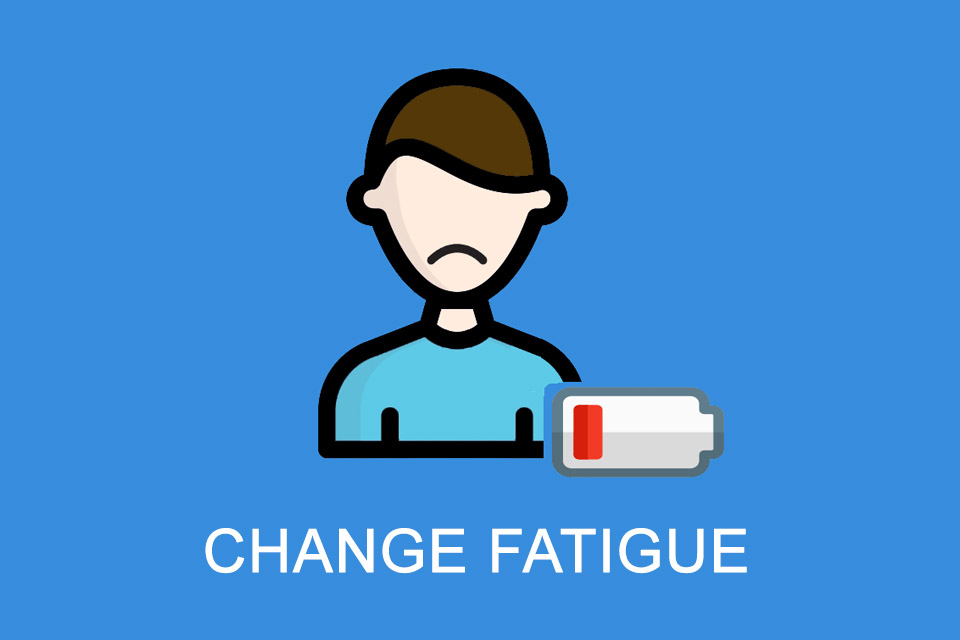What is Change Fatigue?
Smartpedia: Change fatigue refers to the tiredness and exhaustion of employees triggered by too many failed, parallel or planned changes within an organisation.
Change fatigue – the tiredness of employees for change
“Standing still is going backwards”¹ – this motto still applies in many companies today. Companies are in competition with each other and must continuously adapt themselves and their products or services to the needs of their customers. Often these adaptations result in change projects, adapted processes, new procedures or organisational restructuring. The amount and scope of change often leads to change fatigue.
Change fatigue is the feeling of being overwhelmed and exhausted by constant change.² It can result from a combination of factors, such as
- lack of control over the changes,
- lack of understanding of the reasons for the changes, and
- lack of support during the transition.
Change fatigue can also be exacerbated by multiple changes at the same time or by changes that are perceived as unnecessary or unrelated to stakeholders’ goals.
Change Fatigue symptoms and measures
Change fatigue can be identified by symptoms such as
- an increased level of stress,
- a decrease in motivation and commitment,
- a lack of energy or concentration, and
- a general feeling of apathy or cynicism towards new initiatives or projects.
If a company detects change fatigue within the organisation, it is advisable to implement some measures:
- Open and transparent communication: when something changes, it is important to communicate the reasons for it and the benefits for the individual and the organisation, as well as the process plan. This will ensure, at least to some extent, that everyone is informed and understands the change and their role in it.
- Encourage participation and feedback: It is advisable to actively involve staff in the change process by giving them a say and listening to feedback. Employees who feel that their opinions and concerns are being heard are more likely to at least not resist the change and may even advocate for it.
- Address resistance: Change is often met with resistance and it is important to recognise and address this resistance. By identifying the source of resistance and addressing it, organisations can reduce resistance and, if necessary, increase support for the change step by step.
- Provide support and resources: Organisations should provide sufficient capacity and resources needed to manage change. This may include training, coaching or additional staff.
- Prioritise self-care and well-being: Change can be stressful and it is important to prioritise staff wellbeing during this time. Ideally, organisations should encourage their staff to take care of themselves both physically and emotionally. Again, it is advisable to actively provide resources and support.
- Take a break: Sometimes fatigue arises from too many parallel changes or too many changes in too short a time. In such cases, it may be useful to take a break and not introduce any new changes for a while to allow the organisation and staff to recover and adapt.
- Assess and adjust progress: Organisations should be sure to assess the progress of the change with stakeholders and make adjustments as needed. It is important to take into account feedback and the impact of the change on employees.
- Celebrate successes: Often organisations forget to celebrate successes. Successes help maintain momentum and reduce fatigue.
It is also important to know that change fatigue is not always caused by change initiatives or major organisational changes, but can also be caused by a lack of direction, uncertainty or progress in an individual’s career or work. It is therefore important to also identify and address the real underlying problems.
Change fatigue and groupthink
Groupthink is a phenomenon that can occur when the cohesion of a group seems more important than the consideration of real facts, objective analysis or critical thinking in group decision-making. This can lead to a lack of diversity of perspective, an overestimation of the group’s capabilities and decisions, and a failure to consider alternative options or risks.³
Groupthink can have a significant impact on change fatigue, as it can lead to changes that are not well thought out or supported by the group and may not be in line with the goals of the individual members of the group. If changes are made without proper thought or input, they may be perceived as arbitrary or unnecessary, which in turn can contribute to change fatigue.
In addition, groupthink can also lead to a failure to openly discuss the proposed change and its potential impact. If group members feel pressured to conform to the group consensus and not to question it, this can lead to frustration and lack of motivation.
To prevent groupthink from having a negative impact on change fatigue, it is important for groups to actively promote different perspectives and involve all members of the group in the decision-making process. This can be achieved through techniques such as brainstorming and debates, and by using external experts or consultants to provide objective analysis and feedback. In addition, it is important to clearly communicate the rationale for change and transparently present the potential risks and benefits so that individual members can make an informed decision about whether or not to support the change.
Resilience as a possible answer to change fatigue
Resilience can be a helpful tool in dealing with change fatigue. It refers to a person’s ability to adapt and cope with difficult situations, such as change, and to recover from adversity. Those who are resilient are better able to cope with stress, manage their emotions and maintain a positive attitude in the face of change.
Resilience can help reduce change fatigue in several ways:
It provides a sense of control: resilience can help people feel they have more control over their lives, which can be particularly important in times of change. When people feel they have some control over the changes happening around them, they are less likely to feel overwhelmed and fatigued.
By promoting positive thinking: resilience can help individuals to adopt a more positive and hopeful perspective, which can be important in times of change. Positive thinking can help reduce stress and anxiety and promote a sense of well-being.
By promoting flexibility: Resilience can help individuals become more adaptable and open to new ideas and ways of doing things. This can be particularly important in times of change when new processes and procedures are introduced.
By promoting self-care: Resilience often includes self-care, e.g. getting enough sleep, eating healthily, exercising regularly and managing stress. When individuals take care of themselves, they are better able to cope with the demands of change.
Resilience is not something you are born with, but something you can develop over time. It takes time and effort, but by building resilience one can develop the necessary skills to better manage change and reduce change fatigue.
Impulse to discuss
On a scale of 1 to 10, how confident are you in your ability to successfully manage current changes in your organisation?
If you like the article or would like to discuss it, please feel free to share it in your network. And if you have any comments, please do not hesitate to send us a message.
[1] The quote ” Standing still is going backwards” is attributed to the German industrial manager Rudolf Christian von Bennigsen-Foerder.
[2] Change fatigue also exists in the private sphere.
[3] See also Abilene Paradox
And here you will find additional information from our t2informatik Blog:



